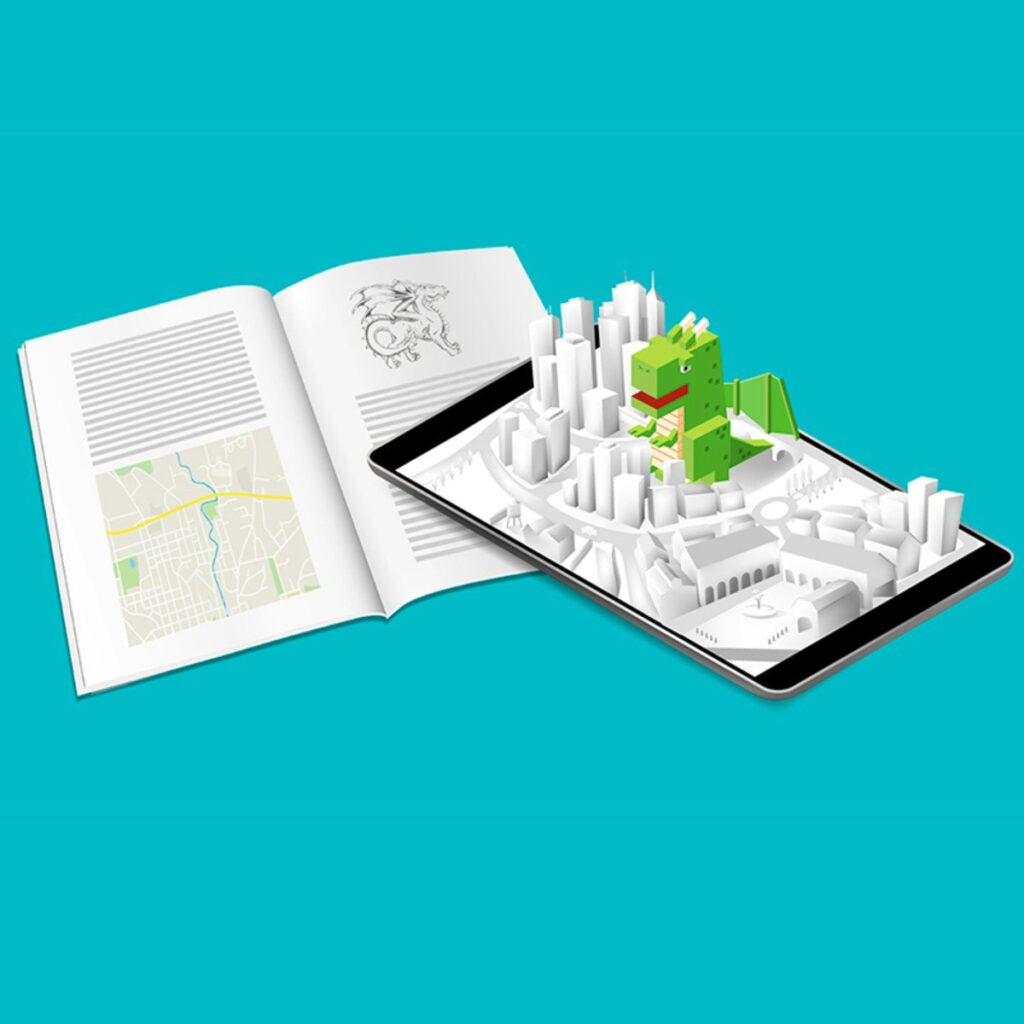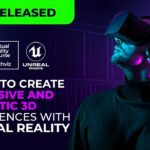Now, if the words "Augmented Reality" make your brain do a little flip-flop, or if you picture tech wizards in dark rooms typing furiously, let me assure you, that’s exactly where I started. I was a curious beginner, just like you might be right now, peering over the edge of a fascinating new world. And let me tell you, it was one of the most exciting adventures I’ve ever embarked upon.
The Spark: Why Even Bother with Augmented Reality?
Before I tell you about the course itself, let’s talk about why I even considered it. For the longest time, my understanding of "Augmented Reality" was limited to Snapchat filters – you know, the ones that put dog ears on your head or turn your friend into a potato. Fun, sure, but hardly groundbreaking, right?
Then, I started noticing other things. A furniture app that let me place a virtual sofa in my living room to see how it looked before buying. A museum exhibit that brought ancient artifacts to life on my phone screen. Or even just seeing someone use their phone to translate a foreign menu in real-time, right there on the screen, overlaid on the physical text.
My jaw practically hit the floor. This wasn’t just a filter; this was magic. It was the real world, enhanced, enriched, made more useful and more delightful. It wasn’t about escaping reality like Virtual Reality; it was about improving it. A tiny spark ignited in my mind: "Could I make something like that? Is learning AR even possible for someone like me?"
That spark quickly grew into a burning curiosity. I realized AR wasn’t just a gimmick; it was a powerful tool with the potential to change how we learn, work, shop, and play. It felt like the future was whispering right in my ear, and I wanted to be part of the conversation. That’s when I knew I needed to find an Augmented Reality course.
The Quest for Knowledge: Choosing My Augmented Reality Course
Okay, so I was hooked. But where do you even begin when you want to learn something so seemingly complex? My first thought was, "This is going to be incredibly difficult. I probably need a computer science degree or something."
But I was wrong. The beauty of today’s online learning landscape is that there are fantastic resources tailored for all levels, especially for beginners. My search for an AR course for beginners led me down many rabbit holes. I looked for a few key things:
- Beginner-Friendly Language: I needed something that didn’t assume I knew what an "SDK" or a "spatial anchor" was. I wanted concepts explained clearly, like you were talking to a friend.
- Hands-on Projects: I learn by doing. Reading about AR is one thing; actually building something, however small, is another. I wanted a course that had me creating from day one.
- Tool Agnostic (or at least popular tools): I quickly learned that many AR experiences are built using game engines like Unity. So, a course that taught me Unity basics alongside AR concepts seemed like a smart move.
- Community and Support: Learning something new can be lonely. I hoped for a course with a forum or a community where I could ask questions and connect with others.
After sifting through a few options, I finally settled on an online Augmented Reality course that promised a gentle introduction to the core concepts and practical application using Unity and AR Foundation (which helps you build for both Apple’s ARKit and Android’s ARCore – more on those later!). It felt like finding the perfect map for an exciting treasure hunt.
Day One: Stepping into the Unknown (and Not Breaking Anything!)
My first few days in the Augmented Reality development course were a mix of excitement and mild panic. The first step was downloading Unity, the game engine. It looked… intimidating. So many buttons! So many windows! It felt like trying to fly a spaceship before I even knew how to open the door.
But my instructor, bless their patient soul, walked us through every single step. "Don’t worry," they said, "we’re just setting up our workbench." We learned how to navigate the Unity interface, how to import 3D models (a fancy word for virtual objects), and how to set up our development environment. It was like learning a new language, one word at a time.
Then came the first "Aha!" moment. We were introduced to the concept of AR Foundation. This is essentially a bridge that lets your Unity project talk to the AR capabilities of your phone (whether it’s an iPhone using ARKit or an Android using ARCore). It sounds technical, but the course broke it down: "Think of it as the magic glue that connects your virtual stuff to the real world through your phone’s camera."
My first actual AR project? Placing a simple cube on my desk. It sounds trivial, doesn’t it? But when I built the project, put it on my phone, and pointed my camera at my real-life desk, and there it was – a perfectly rendered, virtual cube sitting right on my physical surface – my jaw dropped again. It felt like pure magic. It wasn’t a trick; it was my code, my creation, interacting with my world. That feeling of seeing something you’ve built come to life in such an interactive way is utterly exhilarating.
The Building Blocks: From Cubes to Creations
As the AR course progressed, we moved beyond simple cubes. We started exploring more complex concepts:
- Plane Detection: This is how your phone "sees" flat surfaces like floors, tables, and walls. The course showed us how to visualize these detected planes and then place objects precisely on them. Suddenly, that virtual sofa in my living room app made perfect sense!
- Object Tracking: Imagine pointing your phone at a specific image – say, a poster – and having a 3D animation pop out of it. We learned how to make that happen. This felt like truly unlocking the secrets of those museum exhibits.
- User Interaction: What if you want to tap on a virtual object and have it do something? We delved into making objects respond to touches, rotate, scale, or even trigger sounds. This is where the experiences started becoming truly interactive.
- Persistent AR: This was mind-blowing. We learned how to "save" the location of our virtual objects in the real world, so if you closed the app and reopened it later, that virtual object would still be there, exactly where you left it. Think of leaving a virtual sticky note for a friend in a specific real-world spot!
There were moments of head-scratching, I won’t lie. My code decided to take an unscheduled coffee break more than once, and sometimes a 3D model just wouldn’t appear where it was supposed to. But the course material was always there, explaining common pitfalls, and the community forum was a lifesaver. Other learners, just like me, were sharing their struggles and solutions. It was like having a team of fellow explorers on this grand adventure.
The "Aha!" Moments and the Power of Community
One of the most rewarding parts of the Augmented Reality development course wasn’t just learning the technical skills, but experiencing those "Aha!" moments. The moment when a complex concept suddenly clicked, when a piece of code finally worked, or when a project you’d been struggling with finally compiled and ran flawlessly on your phone. Those moments are pure gold.
Our instructors weren’t just teachers; they were guides. They didn’t just tell us how to do things, but why. They encouraged experimentation, reminding us that it’s okay for things to break, because that’s how we learn to fix them.
And the community! Oh, the community was wonderful. We shared our little projects – a virtual pet scampering across a real floor, an interactive educational model of the solar system appearing on a table, a simple AR game where you popped virtual balloons floating in your room. Seeing what others were creating, and getting feedback on my own work, fueled my motivation and creativity. It made the journey feel less like a solo climb and more like a shared expedition.
Who is an Augmented Reality Course For? (Spoiler: It’s Probably You!)
You might still be thinking, "This sounds cool, but is an AR course really for me?" My answer is a resounding YES. And here’s why:
- The Curious Explorer: If you’re fascinated by new technologies and want to understand how they work, this is a fantastic entry point.
- The Creative Soul: Are you a designer, artist, or storyteller? Imagine bringing your creations to life in the real world! AR is a new canvas.
- The Aspiring Developer (even without prior experience): Many AR courses, especially those for beginners, start from scratch. You don’t need to be a coding genius. Many tools are becoming more visual and intuitive.
- The Educator: Imagine making learning more engaging by bringing virtual lessons into the physical classroom.
- The Marketer or Business Owner: Think about innovative ways to showcase products or engage customers. AR is a powerful tool for immersive experiences.
- Anyone Who Wants to Future-Proof Their Skills: AR is not a fad. It’s a foundational technology that’s only going to become more prevalent. Learning it now puts you ahead of the curve.
The beauty is that you don’t need to become a full-time AR developer. Just understanding the principles and being able to create simple experiences opens up so many possibilities, both professionally and personally.
My Top Tips for Aspiring AR Explorers
If my story has sparked even a tiny bit of interest in taking an Augmented Reality course, here are a few friendly tips from someone who’s been there:
- Start with a Beginner-Friendly Course: Don’t jump into advanced topics. Find a course specifically designed for novices that builds concepts gradually.
- Be Patient with Yourself: Learning anything new takes time. There will be frustrating moments. That’s normal. Take breaks, walk away, and come back with fresh eyes.
- Don’t Be Afraid to Break Things: Experiment! Change values, move objects, see what happens. You learn so much by trying things out, even if they don’t work as expected.
- Practice Consistently: Little and often is better than long, infrequent sessions. Even 30 minutes a day can make a huge difference.
- Join a Community: Whether it’s the course’s forum, a Discord server, or a local meetup group (online or in person), connecting with others makes the journey richer and provides invaluable support.
- Build Small Projects: Don’t try to create the next Pokémon Go on your first attempt. Start with placing a cube, then a sphere, then make the cube spin. Celebrate every small victory.
- Use Your Phone! The coolest part about AR development is seeing your creations come to life on your actual phone. Test frequently.
The Future is Augmented: My Continued Journey
As my Augmented Reality course came to an end, I didn’t just walk away with a certificate; I walked away with a whole new skillset, a fresh perspective, and a renewed sense of creative possibility. I can now confidently talk about AR concepts, understand the underlying technology, and – most importantly – build simple, interactive experiences that bridge the digital and physical worlds.
The world of Augmented Reality is still evolving at lightning speed. From smart glasses that seamlessly integrate digital information into our vision, to holographic meetings, to entire cities overlaid with interactive content, the potential is boundless. And by taking that first step with an AR course, I feel ready to explore whatever comes next.
So, if you’ve been curious, if you’ve been watching from the sidelines, or if you simply want to unlock a new superpower for your creativity, I wholeheartedly encourage you: find an Augmented Reality course and start your own adventure. You might just discover a magic you never knew you possessed. The future isn’t just coming; it’s already here, waiting for you to augment it.



